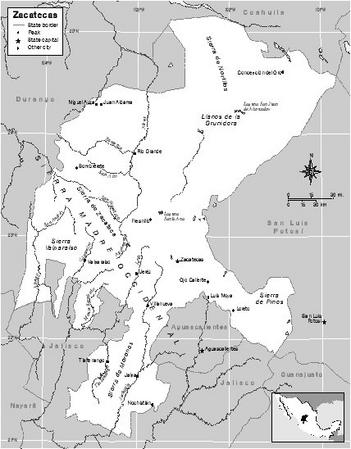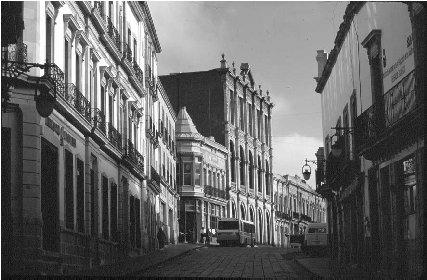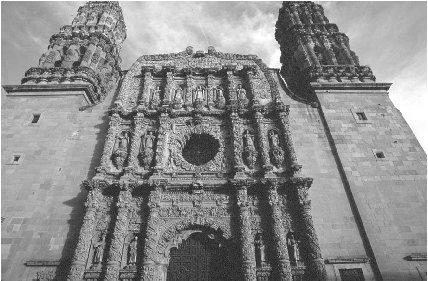Zacatecas

Pronunciation: zah-kah-TEE-kahs
Origin of state name: Original inhabitants of the region were called zacatecas by their neighbors, which means "the people who live on the edge of the zacate (field)."
Capital: Zacatecas.
Entered country: 1823.
Coat of Arms: The city of Zacatecas was founded by the Spaniards, and the coat of arms depicts the arrival of the Spaniards, surrounded by weapons of the native inhabitants they found.
Holidays: Año Nuevo (New Year's Day—January 1); Día de la Constitución (Constitution Day—February 5); Benito Juárez's birthday (March 21); Primero de Mayo (Labor Day—May 1); Revolution Day, 1910 (November 20); and Navidad (Christmas—December 25).
Flag: There is no official state flag.
Time: 6 AM = noon Greenwich Mean Time (GMT).
1 Location and Size
Zacatecas is located in north-central Mexico. It covers an area of 75,040 square kilometers (28,973 square miles), which is smaller than the US state of South Carolina. It is bordered by the Mexican states of Aguascalientes, Coahuila, Durango, Guanajuato, San Luis Potosí, Jalisco, Nayarit, and Nuevo León. Zacatecas has 57 municipalities. The capital city is Zacatecas.
The deepest ravine in Zacatecas, Las Lecheras, measures 3,050 meters (10,000 feet) deep. It is surrounded by mountains ( sierras ), including the Las Bocas Sierra, the Sombrerete Sierra, Los Huacales, Los Alamos Sierra, Chapultepec Sierra, Pico de Teira, Grande Hill, Los García Plateau, and Zuldaca Sierra.
There are many hills in the state—some of them rise more than 2,500 meters (8,250 feet) above sea level. They form part of mountain ranges such as the Sierra Madre Occidental and the Sierra Madre Oriental. The Sierra Madre Occidental is the main mountain range crossing the state.
There are two river basins: the Pacific and Interior Basins. The rivers of the Pacific Basin are very long and run through other states before reaching the Pacific Ocean. The main rivers are the San Pedro, Juchipila, Jerez, Tlaltenango, San Andrés, Atengo, and Valparaíso. The rivers of the Interior Basin do not reach the sea. They are the Calabacillas, Zaragoza, Los Lazos, San Francisco, and Aguanaval.
2 Climate
The northern plateau location of the capital, Zacatecas, has a chilly climate in winter. In summer the climate is mild and dry, with the temperature averaging 17° c (62° f ). The average annual rainfall is 28 centimeters (11 inches).
3 Plants and Animals
The state can be divided into three natural regions: the Sierra Madre Oriental in the north, the Central Plateau, and the Sierra Madre Occidental in the south. The northern region has palm trees, nopal cactus, yucca, and huizache. The central region is mostly pastureland, and the south has oak forests as well as pastures and thickets.
Common animals include coyotes, wildcats, tlacuaches (Mexican opossums), deer, and wild boar. Common birds include wild turkeys, macaws, and eagles.
4 Environmental Protection
The Sierra de Organos is a protected national park.
5 Population, Ethnic Groups, Languages
Zacatecas had a total population of 1,353,610 in 2000; of the total, 653,583 were men and 700,027 were women. The population density was 18 people per square kilometer (46 people per square mile). In 2000, the capital, Zacatecas, had a population of 123,700.
Almost all citizens speak Spanish as their first language. Less than one percent of the population speaks indigenous (native) languages.
6 Religions
According to the 2000 census, 84% of the population, or 1.1 million people, were Roman Catholic; about 2%, or 23,098 people, were Protestant. That year there were also 2,441 Seventh-Day Adventists, 7,861 Jehovah's Witnesses, and over 23,000 people who reported no religion.
7 Transportation
The state has about 9,742 kilometers (6,051 miles) of roads and about 670 kilometers (416 miles) of railroads. There is one international airport.
8 History
Before the arrival of Spanish settlers, Zacateco, Caxcán, and Guachichile groups inhabited the region. Although most were hunters and gatherers, a few settlements existed in the area when Spanish conquistadors (those who came to Mexico in order to claim it for Spain) Cristóbal de Oñate and Pedro Almendez Chirinos, lieutenants in the Nuño Beltrán de Guzmán expedition, organized a militia of Spanish soldiers and Mexica and Tlaxcaleca Indians


Looking down Avenue Hidalgo in the capital, Zacatecas. The three-story building is the Theater Calderón, named in honor of Mexican playwright Fernando Calderón. The first performances were given there in May 1887.
After finding silver in the region in 1548, the Spanish stepped up their presence in Zacatecas. The city of Zacatecas, which had been destroyed, was rebuilt, and Zacatecas was made into a province of New Galicia. Several silver mines were put into operation. Indian rebels attacked the convoys that transported silver to Mexico City, reflecting the difficulties the Spaniards had in exercising control over the region. Known as the silver paths, the roads that led from Zacatecas to the rest of the country were the center of indigenous resistance and sabotage against mining and commercial activity. Mining activity continued to grow until the mid-17th century, when financial difficulties severely hindered silver production. Indian groups and runaway slaves brought from Africa continued to attack Spanish settlements and travelers who went from Zacatecas to neighboring Guadalajara in Jalisco.
Because mining activity had picked up again in the late 18th century, the independence movement sought support in Zacatecas in 1810, hoping to benefit from the silver production in the region. When troops loyal to the Spanish crown defeated the independence army of Miguel Hidalgo y Costilla (1753–1811), many pro-independence fighters escaped to Zacatecas until the royalist troops occupied the city in 1811. Zacatecas joined the new federal republic when national independence was finally achieved in 1821. The state was formally incorporated in 1823 and a new constitution was written in 1825.
Political and military conflicts between centralists and federalists and between liberals and conservatives characterized much of the 19th century in Zacatecas. When the liberals finally defeated conservatives and Benito Juárez (1806–1872) became president for a second time in 1867, Zacatecas experienced a period of social peace and economic progress. In 1880, Governor García de la Cadena ran against Porfirio Díaz (1830–1915) for the presidency of Mexico. He was defeated but revolted against Díaz who was just beginning what turned out to be the longest presidential tenure in the history of Mexico (1876–1910).
Different factions fought in Zacatecas during the Mexican Revolution, which started in 1910, but by 1917 the revolutionary victors were already in control of the region. Zacatecas joined the other states in sending delegates to write the new Mexican Constitution of 1917. During the rest of the 20th century, the Institutional Revolutionary Party (PRI), the dominant political party following the Mexican Revolution, tightly controlled politics in the heavily populated and agriculturally rich region.
9 State and Local Government
The highest authority in the state is the governor, elected democratically every six years for a nonrenewable term. The state legislature is a unicameral (single) chamber comprised of twenty-one members. Deputies are elected for nonrenewable three-year terms from both single member districts and by proportional representation. Until the opposition Party of the Democratic Revolution (PRD) won the gubernatorial election in 1998, the Institutional Revolutionary Party (PRI) governors exerted overwhelming influence over state powers.
The fifty-seven municipalities that comprise Zacatecas hold democratic elections for municipal presidents and council members every three years. Immediate re-election is not allowed. Although some decentralization initiatives are producing positive results, the state still has a long way to go to achieve successful decentralization.
10 Political Parties
The three main political parties in all of Mexico are the Institutional Revolutionary Party (PRI), the National Action Party (PAN), and the Party of the Democratic Revolution (PRD). Although the PRI historically controlled politics in the state, the PRD won the 1998 gubernatorial elections. Ricardo Monreal became the first non-PRI governor of the state. Yet, the PRD is strongest in urban areas, with the PRI retaining a majority control of the rural vote. The PAN also has grown in urban areas and its support for Monreal was essential to defeating the PRI in one of its strongholds. A former PRI member, Monreal resigned from that party to join the PRD a few years earlier.
11 Judicial System
The Superior Tribunal of Justice is the highest court in the state. The state governor appoints its seven members with approval from the legislature. Only qualified attorneys with a proven record can be appointed to the court. Justices can be reappointed at the end of their terms. Although the constitution guarantees the independence of the judiciary, the excessive influence exerted by PRI governors in the past prevented that autonomy from being freely exercised. In addition, an electoral tribunal and lower courts also comprise the state's judicial system.
12 Economy
Agriculture and livestock account for about 25% of the economy. Service-based companies account for about 21% of the economy, followed by finance and insurance at 19%, trade activities at 14%, transportation and communications at 7%, construction at 5%, manufacturing at 5%, and mining at 4%.
13 Industry
Most of the industries in the state are focused on food processing. There are some foreign companies with facilities in the state, including Oro Control and Packard Electric.
14 Labor
The US Bureau of Labor Statistics reported that Mexican workers saw their wages increase 17%, from $2.09 per hour in 1999 to $2.46 per hour in 2000. (The average US worker earned $19.86 per hour in 2000.) After one year, workers are entitled by law to six days paid vacation.
15 Agriculture
Agriculture is the main economic activity in the state. The most important crops include guavas, grapes, apples, peaches, and strawberries. Corn and potatoes are important staples. Cattle and sheep are the primary livestock animals.
16 Natural Resources
Mexico produces approximately 17% of the world's total annual output of silver. Zacatecas produces about 40% of the country's total silver output. The largest mine is near Fresnillo.

This elaborate cathedral in the capital, Zacatecas, dates from the eighteenth century.
17 Energy and Power
Almost all of the energy in Mexico is provided by the Federal Electricity Commission (CFE). In February 2002, the CFE introduced new electric rates. For households that use less than 140 kilowatt hours per month, there was no rate increase. (This is about 75% of all households in Mexico, according to CFE).
18 Health
There are 14 general hospitals, 394 outpatient centers, and 34 surgical centers in the state of Zacatecas.
Most of the Mexican population is covered under a government health plan. The IMSS (Instituto Mexicano de Seguro Social) covers the general population. The ISSSTE (Instituto de Seguridad y Servicios Sociales de Trabajadores del Estado) covers state workers.
19 Housing
Only about one-half of the housing available in the state of Zacatecas is in good repair. More than 16% is in need of significant upgrading. Many homes do not have running water or access to electricity.
20 Education
The system of public education was first started by President Benito Juárez in 1867. Public education in Mexico is free for students from ages six to sixteen. According to the 2000 census, there were approximately 335,700 school-age students in the state. Many students elect to go to private schools. The thirty-one states of Mexico all have at least one state university. In Zacatecas, there is Universidad Autónoma de Zacatecas (Independent University of Zacatecas).
21 Arts
Most of the cities and towns of Zacatecas have local cultural centers. In all, the state has forty-nine local cultural centers and eight theaters. There is a large auditorium for performing arts groups in the city of Zacatecas.
22 Libraries and Museums
The state has 209 libraries and thirty-three museums. Major museums in the capital, Zacatecas, are a museum of abstract art, a science museum, a museum of pharmacy, a blacksmith museum , and a museum of local history. A mineralogy museum is located at the Universidad Autónoma de Zacatecas.
23 Media
The capital, Zacatecas, has two daily newspapers, El Sol de Zacatecas and Imágen.
24 Tourism, Travel, and Recreation
The capital, Zacatecas, is an old mining town founded in 1546. There are silver mines open to tourists. Zacatecas is known for its fine ironwork and for its buildings of pink sandstone. Tourists visit the cathedral (which dates from the 18th century) and Enrique Estrada Park, which has an aqueduct from the 18th century. Special events include the Zacatecas Fair (second week of September) and the De la Morisma Fair (celebrated the last three days in August).
25 Sports
There are two basketball teams in the state: Barreteros (in the capital, Zacatecas) and Gambusinos (in Fresnillo). The soccer team, Real Sociedad Zacatecas, plays in the 16,000-seat Francisco Villa stadium in the capital.
26 Famous People
Francisco "Pancho" Villa (born Doroteo Arango, 1878–1923) was born in Rio Grande but was known as a bandit revolutionary in Chihuahua and Durango. He has been called the Mexican Robin Hood. Composer Manuel María Ponce (1886–1948) may be best-known for his works for guitar. Refugio Reyes Rivas (1862–1945), a developer whose works transformed the city of Aguascalientes, was born in La Sauceda.
27 Bibliography
Books
DeAngelis, Gina. Mexico. Mankato, MN: Blue Earth Books, 2003.
Supples, Kevin. Mexico. Washington, DC: National Geographic Society, 2002.
Web Sites
Mexico for Kids. http://www.elbalero.gob.mx/index_kids.html (accessed on June 15, 2004).
Angelina Gonzalez
I am second generation born here in the United States. My Grandmother and her Brother became separated from other family members when they fled the war. My Mother and Grandparents are deceased and I have questions that I have regarding family history.
Zacatecas is very interesing and wonderful, i will like to visit it once or twice, its cool and incredible!
Nice work gays!